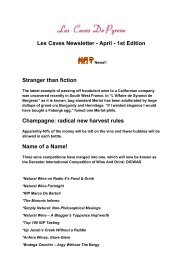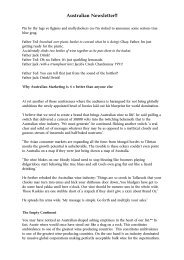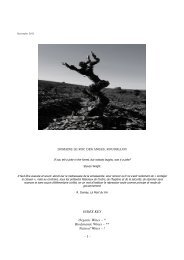Download our list here - Les Caves de Pyrene
Download our list here - Les Caves de Pyrene
Download our list here - Les Caves de Pyrene
Create successful ePaper yourself
Turn your PDF publications into a flip-book with our unique Google optimized e-Paper software.
CAHORSWine should be drunk neatIn the morning, withoutWater at mid-day, and inThe evening just asThe Good Lord gave it to us!Old Aveyron proverb – quoted in Paul Strang’s Wines of South-West FranceCahors has enjoyed a long and complex history. Vines were originally introduced by the Romans, and when theriver Lot was eventually adapted as a trading waterway, the reputation of Cahors became established all over theworld. By the 14 th century Cahors was being exported throughout Europe including England (w<strong>here</strong> it earned thesobriquet of “The Black Cahors!”) and Russia; it was even consi<strong>de</strong>red superior to Bor<strong>de</strong>aux in France. Paul Strangquotes Monsieur Jullien in his book Wines of South-West France <strong>de</strong>scribing this strange black wine: “They make apoint of baking a proportion of the grapes in the oven, or bringing to the boil the whole of the vintage before it isput into barrel for its natural fermentation… The first-mentioned process removes from the must quite a lot of thewater content of the wines, and enc<strong>our</strong>ages a more active fermentation in which the col<strong>our</strong>ing agents dissolveperfectly”. Tastes change… now one can find wines ma<strong>de</strong> by carbonic maceration. Pascal Verhaeghe from Châteaudu Cèdre has just started using the micro-oxygenation technique (pioneered by Patrick Duc<strong>our</strong>nau in Madiran) tocreate wines of great suppleness, whilst Jean-Luc Bal<strong>de</strong>s has just created his version of the original black wine. Bythe way, an anagram of Cahors Auxerrois is “Ou! Six Rare Cahors!” Sometimes, as Voltaire said, the superfluous isvery necessary.CHATEAU DU CEDRE, PASCAL VERHAEGHE, Cahors – OrganicIf you think that Cahors is just brushing y<strong>our</strong> teeth with tannin-flav<strong>our</strong>ed twigjuice, think again!Pascal Verhaeghe has been the driving force behind the Cahors “Quality Charter” and quality oozes from these wines.The estate was originally created by Charles Verhaeghe on vineyard land <strong>de</strong>vastated by the frosts in 1956 in Viré-Sur-Lot. His sons Pascal and Jean-Marc duly studied winemaking, the former in Burgundy and California, the latter inBor<strong>de</strong>aux. Ecological viticultural methods eschewing weedkillers and chemical fertilizers, yield reduction by seriouspruning, leaf stripping for greater sun exposure and air circulation, harvesting the grapes on the verge of overripenessyield the superb raw material essential to create fabulous wines. In the cellars the Verhaeghes aim for softness,richness and harmony through gentle extraction by long vattings and limited pigeage, malolactic fermentation andsensible use of oak.The Heritage du Cèdre is the Pugsley in this Addams menagerie. The family traits of abundant dark brooding fruit areevi<strong>de</strong>nt; the heart is black but the flesh is youthful. It’s lunchtime and you could mur<strong>de</strong>r a Cahors, but you don’t fancytaking out one of the big guns. Heritage is for you, a bonny ruby-red, the Malbec softened by plummy Merlot soothingto the gullet, a nice touch of lip-smacking acidity. It quacks duck magret to me.The Cahors is inky, spicy red wine endowed with red and black fruits and smoked fig and liquorice flav<strong>our</strong>s. A mixtureof new and old oak, the top cuvées are ma<strong>de</strong> from low yields and old vines on the estate. The grape variety <strong>here</strong> isMalbec (also known locally as Auxerrois), supplemented by smidgens of Merlot and Tannat. We also receive a healthyallocation of his remarkable top treacle-thick cuvée “Le Cèdre”, ma<strong>de</strong> from the ol<strong>de</strong>st vines on the estate, “as cypressblack as e’er was crow”, sweet, perfumed and plum-pruney. Decant and be awed. This is 100% Malbec from 30-40year old vines and miserly yields of 30hl/ha. The recipe is exacting: a tri <strong>de</strong> vendange, <strong>de</strong>stemming, a light pressing,vinification at 30-32 <strong>de</strong>grees with pigeage and a 40 day cuvaison followed by 100% malolactic fermentation in new oakbarrels. The wine is then aged for twenty months w<strong>here</strong> it acquires its fabulous col<strong>our</strong>, almost impenetrably dark withglossy purple tints. With its thick cassis aromas and wild raspberry fruit this is a meal in itself and should be eaten withgreat reverence and a long spoon. Now top that – and we have – with Le Grand Cèdre. From vines yielding a mere15hl/ha this black beauty, a thoroughbred in a fine stable of Cahorses, is aged in 500-litre new oak <strong>de</strong>mi-muids withlong lees contact, and is, as Andrew Jefford <strong>de</strong>scribes it so eloquently “strikingly soft, lush and richly fruited, a kind ofPomerol amongst Cahors”.The Cèdre wines repay long ageing and will accompany local goat’s cheeses such as Cabecou and Rocamad<strong>our</strong>,grilled meats and duck every which way.2011 HERITAGE DU CEDRE R2009 CAHORS R2010 CAHORS – ½ bottle R2009 CAHORS, CUVEE PRESTIGE – magnum R2007 LE CEDRE R2002 LE GRAND CEDRE R- 34 -








